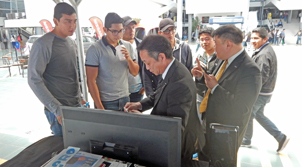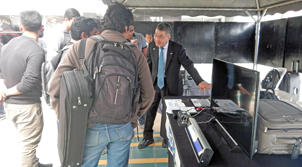The Plurinational State of Bolivia decided to adopt ISDB-T as its national terrestrial TV standard in July, 2010, and started trial broadcasting in September, 2011.
Following their successful 1st digital terrestrial TV seminar in La Paz in January last year after their adoption of ISDB-T, the Ministerio de Obras Públicas, Servicios y Vivienda approached the Embassy of Japan in La Paz to inquire the possibility of holding similar seminars in its major cities of Santa Cruz and Cochabamba, and the Ministry of Internal Affairs and Communications of Japan (MIC) decided to join the seminars in the above two cities. ARIB/DiBEG followed MIC’s decision and dispatched its representatives as a part of their international activities of ISDB-T promotion and technical support.
Seminar held in Santa Cruz
The first Seminar was held in Santa Cruz on May 14 at Universidad Tecnológica Privada de Santa Cruz de la Sierra (UTEPSA), where 195 people participated.

Inside the Seminar Hall at UTEPSA
The Seminar was initiated by welcome speeches by Lic. A. Carvahlo, Principal of UTEPSA, Ing. R. Dorado, Director of ATT and by Mr. D. Sasaki.

Mr. A. Carvahlo

Mr. R. Dorado
Mr. W. Pantoja of the Viceministerio de Telecomunicaciones started his presentation with the features of digital terrestrial TV services; license application steps for simulcasting broadcasters and for other broadcasters who switch to digital terrestrial TV service without simulcasting; and finally explained that the renewed nationwide ASO (Analog Switch-Off) planning in 3 phases.
Mr. Saúl Tumini, Analyst of Information Technology at ATT, explained that;
- the broadcasters undertaking program production through transmission will have a broadcasting license of 15 years, while those operators who manage multiple program providers in one channel will have a license of 5 years;
- there will be 5 business models of utilizing one 6MHz channel;
- The national broadcaster as official media can broadcast multiple programs. And the channel allocation would be 33% for the national broadcaster, 33% for commercial broadcasters, 17% for social community broadcasting, and another 17% for the indigenous and intercultural Bolivian communities;
- The ultimate ASO completion would be by November 30, 2025. There would be some incentive of assigning digital TV frequency earlier to those broadcasters and operators completing the ASO earlier; and,
- There would be technical standards for development of interactive applications based on the Ginga platform.

Mr. W. Pantoja

Mr. S. Tumiri
The Japanese delegation was headed by Mr. D. Sasaki, Deputy Director, Broadcasting Technology Division of MIC, followed by the DiBEG member company representatives from Maspro Denkoh and JTEC (Japan Telecommunications Engineering and Consulting Service), together with Hitachi Kokusai Electric and Toshiba Corp. and a DiBEG secretariat. Mr. M. Katayama, Consul General of Japan in Santa Cruz, also attended the Seminar.
Mr. D. Sasaki of MIC presented the benefits of ISDB-T broadcasting, such as EWBS (Emergency Warning Broadcast System), various data-casting services, hybridcast and mobile reception capabilities, then introduced the completed process of ASO in Japan, and concluded his speech, celebrating that this year is the 120th since the first Japanese immigrants arrived in Bolivia, expecting mutual relations being further strengthened.

Mr. D. Sasaki
Then the DiBEG representatives made presentations respectively;
– The DiBEG secretariat introduced the outline of its technical support and cooperation to those ISBD-T adopting countries;
– Maspro Denkoh (Mr. K. Inukai) presented the TV receiving antenna products and knowhow about the TV signal reception;
– JTEC (Mr. Y. Sakaguchi) explained the EWBS, especially on the Superimpose of emergency warning information onto the Ones-seg broadcasting.
Hitachi Kokusai (Mr. Y. Miyoshi) presented its line of products from TV studio equipment to TV transmitting systems; and Toshiba introduced its latest TV transmitting equipment and technologies.
Mr. Y. Miyoshi, on behalf of the Brazilian SBTVD Forum, presented the outline of the Ginga middleware to the latest version of the Profile D.

Mr. S. Sakuma

Mr. K. Inukai

Mr. Y. Sakaguchi
In an open space inside the campus of UTEPSA, an exhibition was provided. The DiBEG secretariat presented pamphlets introducing its technical support activities on ISDB-T; JTEC demonstrated EWBS functionality; Maspro showed TV receiving antenna products; Hitachi Kokusai exhibited its transmission equipment with a multiplexer; and Panasonic Peru (Bolivian Branch) exhibited its ICT technologies through 2 TV monitors.

Demonstration of antenna

Demonstration of EWBS
Seminar held in Cochabamba
The second Seminar was held on May 15 in Cochabamba, at the hall of Universidad Mayor de San Simon (UMSS), where 204 people attended.

Inside the Seminar Hall at UMSS
With the same delegation from Japan as on the previous day, the Seminar was initiated by welcome speeches by Lic. J. Rios del Prado, Principal of UMSS, Ing. Gustavo Pozo, Vice Minister of Telecommunications, and by Mr. D. Sasaki, followed by the presentations by the same lecturers as on the previous day in Santa Cruz.

Mr. J. Rios

Mr. G. Pozo
As in the UTEPSA campus, UMSS offered an open space for exhibition, where DiBEG, Maspro Denkoh, JTEC and Hitachi Kokusai set up display booths respectively and attracted seminar participants with their displays and demonstrations.
ATT also set up its exhibition booth to introduce their activities, attracting visitors interested in the telecom and broadcasting areas.

Demonstration at the Exhibit Area 1

Demonstration at the Exhibit Area 2


